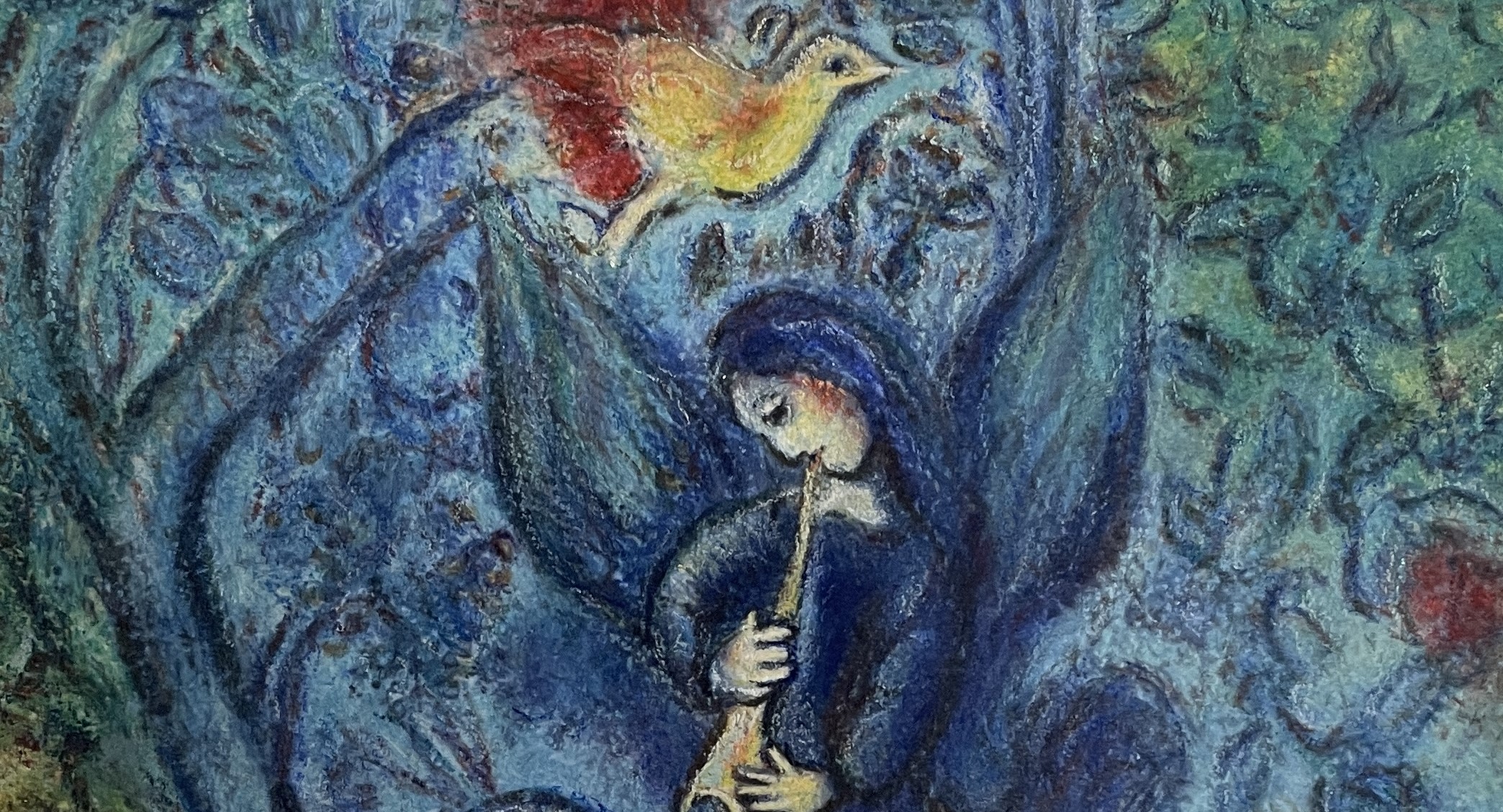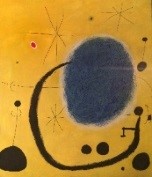日本語-Englishー台灣華語
ジョアン・ミロ「星雲」別名「蒼天の金」
私はかつてスペインで投資活動をしていたので、毎月のようにスペインを訪れていた。バルセロナには何度となく足を運んだものだ。街にはガウディとミロが溢れている。ガウディの偉大さは一見して理解できるが、一見つたないミロがどうして偉大な画家として大成することができたのだろうか。 バルセロナ・オリンピックが開催されたモンジュイックの丘には大きなミロの美術館がある。日本ではあまり観ることがない大きな絵が多数飾ってある。私はミロ財団美術館に作者自身が寄贈した、黄色地に青い大きな円のある「星雲」を描くことにする。
この星雲もかなりの大きさがある。大きなミロの絵には、小さな絵では伺い知ることができない力強さがある。襖程大きな画面に、体位ある筆で水墨画のような線が一気に描かれているのが判る。ミロは形を巧く描けない時に、モチーフを手でなぞったそうだが、ミロの絵を模写するには、ミロの手や体の動きを形態模写することが重要なようだ。ミロの絵は不定形の有機的形が中心を成している。その歪みの中に命が吹き込まれている。
ミロの絵はいざ描いてみると、簡単でかつ難しい。似てはいても、つまらないミロになりがちだ。ミロの絵においては、一つの斑点、一つの渦巻が絵画の主題となっている。モチーフ間の距離や大きさのバランスが重要だ。ミロの絵には循環と均衡がある。ある形が大きさと位置を変えれば、この循環は停止し、均衡は破られてしまう。黒い惑星のようなものはさほど難しくなく描くことができる。太い黒い線は習字だと思えば日本人には比較的容易である。問題は細い線だ。星や人を表わす細い線は何度描き直してもしっくりとこない。細い線は角度や長さが微妙に違うとミロにならない。何よりミロが描いたスピードがわからないのが致命的だ。丸い円の中のぐちゃぐちゃした殴り描きは、いくら描き直してもミロのようにはならない。ミロはきっと楽しみながらそれをやったに違いない。
ミロは言っている。「絵はいつも何かの衝撃が契機となって引き起こされた幻覚から生まれるものだ」と。ミロの絵には高揚した気持ちがそのまま表れている。肉体の衝動に身を任せて絵を描く。キャンバスに描かれた様々な形は、まさにその瞬間にミロの心に表れた現実なのだ。ミロの絵はたとえ抽象的に見えるものでも具体的現実から出発したものなのである。
ミロは人間的にも素朴な人であったようだ。マヨルカ島に移ってからは、海岸に打ち寄せられた漂流物を拾って来てはアトリエに並べていた。写真で見る拾い物は、ミロのアトリエに飾られた瞬間からどこかで見たことがあるミロの絵画や彫刻のように命を持ちはじめる。ミロという人間が人生に行き詰まらない限り、絵も行き詰まらないということなのだろう。ミロは最初の一筆に困るとキャンバスに脱糞して、その痕跡を塗りつぶしたと言うが、まさに自分を素直に吐き出すことが、絵を描くということなのだ。あらゆる地上の束縛から自由になって絵は描けばそれでいいのだと、私はミロに教えられた。
The Gold of the Azure
I once engaged in investment activities in Spain, so I visited Spain almost every month. I have been to Barcelona countless times. The city is overflowing with Gaudí and Miró. The greatness of Gaudí can be understood at a glance, but it makes one wonder how Miró, who seems at first glance to be clumsy, could achieve great success as a painter.
On the hill of Montjuïc, where the Barcelona Olympics were held, there is a large museum of Miró. It houses many large paintings that are rarely seen in Japan. I decided to draw “The Starry Night,” which Miró himself donated to the Fundació Joan Miró, featuring a large blue circle on a yellow background. This nebula is also quite large. In Miró’s large paintings, there is a strength that cannot be perceived in smaller works. You can see that lines resembling ink paintings, as large as sliding doors, are drawn all at once with a well-placed brush. When Miró could not draw a form well, he is said to have traced the motif with his hand, but to copy Miró’s paintings, it seems important to mimic Miró’s hand and body movements. The center of Miró’s paintings is formed by irregular organic shapes, into which life is breathed amidst their distortions.
Attempting to paint Miró’s works, they seem both simple and difficult. It’s easy to end up with a Miró that looks similar but is uninspiring. In Miró’s paintings, a single spot or swirl becomes the theme of the artwork. The balance of distance and size between motifs is crucial. There is a cycle and balance in Miró’s paintings. If a shape changes its size and position, this cycle stops, and the balance is broken. The black planets-like shapes are not too difficult to draw. Thick black lines can be relatively easy for Japanese people if they think of them as calligraphy. The problem lies with the thin lines. No matter how many times I redraw the thin lines representing stars or people, they never seem right. The thin lines do not become Miró’s unless the angle and length are subtly different. Most critically, I do not know the speed at which Miró drew. No matter how many times I redraw the scribbled mess inside a round circle, it does not become like Miró’s. Miró must have enjoyed doing that.
Miró said, “Paintings are always born from hallucinations triggered by some shock.” His paintings directly reflect an elevated mood. He surrendered himself to physical impulses to paint. The various shapes on the canvas are the reality that appeared in Miró’s heart at that moment. Even though Miró’s paintings may appear abstract, they start from concrete reality.
Miró seemed to be a simple person in human terms. After moving to the island of Mallorca, he would pick up driftwood washed ashore and line them up in his studio. The collected items, once placed in Miró’s studio, begin to take on life, resembling the paintings and sculptures of Miró seen elsewhere. As long as the person Miró did not reach a deadlock in life, his paintings also did not. Miró said that when he struggled with the first stroke, he would defecate on the canvas and then cover the traces, which essentially means that expressing oneself honestly is what painting is all about. I learned from Miró that as long as one is freed from all earthly restraints, it is fine to paint as one wishes.
喬安·米羅「星雲」
我曾经在西班牙进行投资活动,因此几乎每个月都会访问西班牙。我多次踏访巴塞罗那。这座城市充满了高迪和米罗的作品。一看就能理解高迪的伟大,但初看似乎笨拙的米罗是如何成为伟大的画家的呢?
在举办巴塞罗那奥运会的蒙特惠克山上,有一个大型的米罗美术馆。在日本,很少见到的大幅作品在这里数不胜数。我决定描绘由作者本人捐赠给米罗基金会美术馆的一幅作品,那是一幅以黄色背景和蓝色大圆圈为特征的“星云”。这幅星云也相当大。大幅的米罗作品中有一种在小幅作品中无法体会到的力量。就像屏风那么大的画布上,可以看到一种像水墨画一样的线条,是用颇具体态的笔一气呵成地绘制的。据说米罗在画不出形状时会用手追踪主题,但似乎复制米罗的作品时,模仿米罗的手和身体动作是很重要的。米罗的作品以不规则的有机形态为中心,这些扭曲中充满了生命。
尝试绘制米罗的作品时,既简单又困难。虽然看似相似,但很容易变成无趣的米罗作品。在米罗的画作中,一个斑点、一个螺旋都成为了画面的主题。主题间的距离和大小的平衡很重要。米罗的作品中存在着循环和均衡。如果某个形状改变了大小和位置,这个循环就会停止,均衡就会被打破。像黑色行星那样的元素并不难绘制。如果把粗黑线条想象成书法,对日本人来说相对容易。问题在于细线。代表星星或人的细线无论如何重画都难以达到满意的效果。细线的角度和长度如果稍有不同,就无法呈现出米罗的风格。最致命的是,我们无法知道米罗绘画时的速度。圆圈中的乱涂乱画,无论怎么重绘都无法达到米罗的效果。米罗一定是在享受这个过程。
米罗说过:“画作总是由某种冲击引发的幻觉所产生。”米罗的画作直接反映了他的高涨情绪。他让身体的冲动引导绘画。画布上的各种形状,正是那一刻米罗心中的现实。即使米罗的作品看似抽象,也是从具体的现实出发的。
人性化方面,米罗似乎是一个朴素的人。移居到马略卡岛后,他常常捡拾海岸上的漂流物带回工作室。照片中看到的这些捡拾物,一旦被摆放在米罗的工作室,就仿佛获得了生命,变得像我们在某处见过的米罗的画作或雕塑。只要米罗这个人不遇到生活的困境,他的画作也不会陷入僵局。据说米罗如果对首笔感到困惑,就会在画布上排泄,然后覆盖痕迹,这正是诚实地表达自己,即绘画的意义。米罗教会了我,只要能摆脱所有地上的束缚去绘画,那就足够了。


